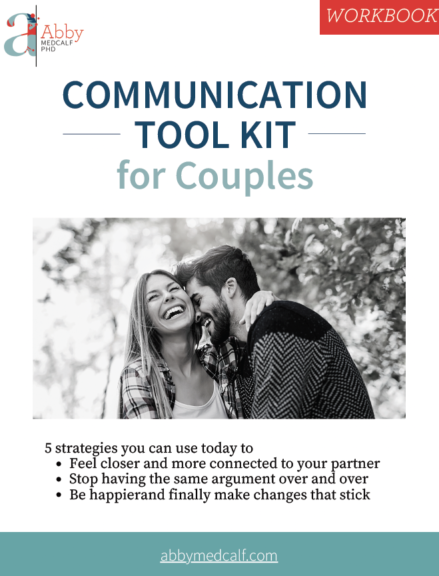
Does your mother make a comment about your haircut, and you blow up? Does your partner casually mention that they’re going out with friends after work, and you get upset and withdraw? When you’re triggered, you have a strong emotional reaction to something that isn’t equal to the situation. Today you’ll learn how to identify when you’re having a trigger and my top tools to effectively deal with triggers in your relationships.
12-minute read
What is a Trigger?
The word trigger has become part of our common language, but it’s often misused or misunderstood. At its most basic, a trigger is when some person, situation or even a smell drives an unconscious thought, feeling or behavior. In other words, you have some reaction that you don’t feel you have control over, and/or you don’t even realize you’re having it! Often, the reaction doesn’t match up or isn’t commensurate with whatever’s going on.
There are emotional triggers, such as your partner mentioning that there’s a new woman at work who was hired about a month ago and you quickly get angry and ask why he’s been hiding this information! And there are situational or physical triggers, such as being a recovering alcoholic and getting on a plane and suddenly having a strong urge to drink (you used to love relaxing on plane rides with a few cocktails).
We’ll mostly be speaking about emotional triggers today but the tips we’ll be discussing will be effective for all types of triggers. In general, triggers can be linked back to different types of trauma. This is why you often have an emotional reaction before you even realize you’re upset or reach for that drink or cookie.
When you hear the word trauma, you might be thinking, “Well, that doesn’t apply to me. I’ve never been the victim of a violent crime or childhood abuse.” But psychological trauma is a very individual experience. I’ve been working with people for almost 40 years, and I can tell you that what traumatizes you might not traumatize someone else. This is why you might not realize you’re dealing with unhealed trauma.
We’re born with certain temperaments and into families at different times in their evolution. We’ve got different genders, and all kinds of other factors that make each person’s childhood slightly different, even when they’re raised in the same family. So how your dad acted as a parent might not have affected your older brother but might have had a negative impact on you.
And trauma can come from neglect just as easily as it comes from overt physical, emotional or sexual abuse. What I find with many of my clients is that they don’t identify something as traumatic because objectively, they think, “Well, I grew up in a good home – intact family, money, best schools, so there was no trauma.” But, when you drill down, maybe their parents never had time for them, and they were shunted off to nannies or other caregivers. Maybe they had an older sibling who bullied them. Maybe they had an undiagnosed learning disability and didn’t live up to their potential, which was always an issue. Maybe they were told they were a drama queen growing up because they showed emotion, which didn’t fit into their family dynamics. There are many ways for us to be left feeling like there’s something wrong with us or that we’re not worthy of love, resulting in unresolved trauma that shows up in later relationships.
Triggers from Later Events
You can also develop triggers from an experienced trauma later in your life, such as:
- Being the victim of some kind of violence
- Being cheated on in a relationship
- Having someone betray you
- Life experiences such as going to war, having your home burn down, losing a job, having a heart attack or being diagnosed with a physical or mental health condition
Triggers and Mental Health
We commonly hear the word trigger when we talk about mental health conditions like PTSD and substance use disorders. However, triggers can also show up with other diagnoses, such as depression, anxiety and eating disorders. In these cases, a trigger will activate or exacerbate mental health symptoms.
For example, during the height of the COVID pandemic, I had many clients who had previously been stable with their depression, alcoholism or anxiety but who became destabilized during the pandemic. (And the research backs me up on this). Being isolated from others or having their life change in such a dramatic way created a situation where they regressed and started feeling more depressed, anxious, irritable or started drinking more.
What Happens When You’re Triggered?
When you get triggered, your autonomic or involuntary nervous system becomes dysregulated and you either get into a state of hyperarousal, which is connected to the fight/flight response or a state of hypoarousal, which is connected to the freeze response. There’s also something called the fawn/fold response, which is also most often connected to hypoarousal. (However, in my own practice, I think this response can be split. In other words, I think some people react with hyperarousal and others with hypoarousal when they fawn).
If people pleasing is an issue for you, it’s time to learn about the fawn response and how to have a healthy response instead.
It’s very important that you identify what normally happens to you when you’re triggered because the tools to use when you’re in hyperarousal are different than what you’d use if you often go into hypoarousal. So let’s talk about both so you can figure out where you land.
Having said that, it would be great to try all of the tips I’ve outlined because you never know what might work for you. So, even if you identify as going into a hypoarousal state when you’re triggered, it might be helpful to try a tool from the hyperarousal list just to see if it works for you as an individual.
I also go into great detail on this topic of managing your emotions in my latest book Boundaries Made Easy: Your Roadmap to Connection, Ease and Joy.
Hyperarousal and the Fight/Flight Response
As I just mentioned, the fight/flight response is also called a hyperarousal state. Basically, this is a heightened state of energy and activation. Your nervous system is on high alert from some trigger and perceived threat (it doesn’t matter if it’s real or not), and you’ll likely be experiencing one or more of the following:
- Hypervigilance (this is a state of high alertness and continually assessing and seeing threats around you)
- Your emotions feel like they’re in hyperdrive
- Anger/Rage/hostility or lashing out
- Fear
- Agitation
- Anxiety or panic
- Emotional overwhelm or what we call emotional flooding
- Racing thoughts
- Hyperactivity
- Inability to relax/restlessness
- Sleeplessness
- Chronic Pain/Tense or rigid muscles
- Nightmares
- Flashbacks
What to Do for the Fight/Flight Response
If you identify with having a fight/flight response when you’re stressed out or upset, I recommend the following specific tools:
I. Straw Breathing
When you’re in fight or flight mode, your sympathetic nervous system is turned on. Your goal is to get your parasympathetic to come on board because this is your rest and digest or calming nervous system pathway. A super simple and quick way to do this is with straw breathing. Here’s what you do:
- Get yourself a straw (I recommend a metal one that you can carry around and re-use)
- Set a timer for 2 minutes
- Take a long slow deep breath in through your nose
- Exhale slowly through the straw
- Repeat this process until your timer goes off
When you breathe this way, it slows down your exhale even more than simply exhaling through your mouth. The slower the exhale, the more calming it is to your system so this technique gives you the most bang for your buck when it comes to calming yourself down.
II. Meditate Daily for 15 Minutes
What Abby? Is this yet another way meditation will improve my life? Why, yes it is! Meditation is a game-changer when it comes to managing your emotions.
Meditation is about focusing your attention and awareness. You’re not trying to turn off your thoughts and feelings as much as you’re trying to observe them without judgment. There are many types of meditation practices. You’ve likely heard about mindfulness or focused meditation, but there’s also walking/movement meditation, mantra, loving kindness and transcendental (to name a few).
Meditation is not about nothing. It’s not about emptying your mind because your mind will absolutely wander, but that’s actually part of the meditation! Meditation is really about focusing on something, noticing that your mind has wandered, and then bringing it back to your original focus.
III. Cognitive Reframing
When you’re in fight/flight mode, your mind is racing, and a tool called cognitive reframing can help slow you down and get back in charge of your thoughts. At its most basic level, cognitive reframing helps you look at a situation, person, thought or feeling from a different perspective. It’s a strategy that helps you open your mindset to a new point of view, a new angle on what’s happening, so you can think differently about it.
This is crucial because you feel the way you think. So, changing your thinking about something will change your feeling about it. That’s how you go from feeling shitty, to feeling at peace about something, so you can stop letting it bother you and stop thinking about it.
You’ve likely heard me say before to think that life is happening for you, not to you. That’s a quick example of a cognitive reframe. Thinking of problems as challenges is another cognitive reframe. I do a deep dive into cognitive reframing in my episode called How to Stop Overthinking and Let Things Go that Bother You.
Hypoarousal and the Freeze/Fawn Response
The freeze response is also known as a hypoarousal state. If the fight or flight response is overactivation, this hypoarousal is all about under-reacting when you’re triggered. In this case, you’ve got too little arousal as a result of an overloaded parasympathetic nervous system.
Hypoarousal or freeze symptoms include:
- Feeling zoned out
- Brain fog or feeling spacey
- Depression/flat affect
- Emotional Numbness
- Lethargy/oversleeping
- Major shutdown mode
- Exhaustion/Chronic fatigue
- Disorientation
- Emptiness
- Disassociation
- Disconnection
- Headaches/nausea
- Feelings of shame and hopelessness
- Being passive and very compliant
Here are my three tips for moving out of the freeze response and that state of hypoarousal.
I. Fake it Till You Make It
Since our nervous systems often take cues from one another, having a motto of “fake it till you make it” can be useful. This means that you can physically make some simple changes that will help shift your mood and this frozen response.
Changing your physiology is one of the quickest ways to help yourself shift out of the freeze response. I’m going to list some suggestions here from the most exertion to the least. All are beneficial, although I’d like you to make it a goal to create a habit of moving your body more, in general, if hypoarousal is an issue for you.
| Highest Exertion | Get your heart rate up by going to the gym, going for a run, playing a sport, jumping rope for a minute or two, or riding a bike. |
| Go for a brisk walk or walk around your home. | |
| Get up and move within your home. Find reasons to stand and move. | |
| Do Superman pose. Stand with your feet shoulder-width apart. Raise your chest while relaxing and lowering your shoulders (they should not be scrunched near your ears). Tilt your head back slightly and raise your face to the sky (or ceiling). Put your hands on your hips (still keeping those shoulders relaxed). Now simply take some deep breaths in through your nose and exhale as slowly as possible through your mouth. | |
|
Lowest Exertion
|
Do the Superman pose modified for a seated position. |
II. Breathe with a Mantra
Having a mantra at the ready for when you’re feeling paralyzed or stuck is a great way to get moving again. You can choose anything as your mantra as long as it satisfies two guidelines: it needs to be uplifting in some way and also something you can believe. Some examples:
- Everything is figureoutable.
- I’ve always found a way before, and I’ll find a way again.
- Right this moment, I’m safe and I’m OK.
- I can do anything I set my mind to.
- All is well, right here and right now.
Now that you have the mantra, couple that with easy breathing. Place one hand on your belly and the other on your chest. You’re going to breathe and ensure that only the hand on your belly moves and there’s no breathing out of your chest. As you take a long slow breath in, feel your stomach expand and that hand rise. As you exhale slowly, feel your stomach contract. The hand on your chest should not move at all for either the inhale or the exhale.
Now, recite your chosen mantra silently along with your breathing. When I do this, I’ll breathe in as I say in my head, “All is well,” and then breathe out as I silently say, “here and now.” Use whatever works for you as you focus on your words and breathing.
III. Grounding Exercises
When you’re in hyper or hypo-arousal states, your brain has been hijacked. Grounding exercises are quick exercises you can do to bring yourself into the present moment where you’re OK and safe. Grounding exercises are simple to use, take just a minute or so and are highly effective! I’ve got a list of five (from the research) that you can download.
Preventative Things You Can Do So You Don’t Get Triggered
Lastly, I want to mention that all of these great tips won’t work if you don’t have some awareness in your moments because you won’t remember to use them! There are two main ways to get better at that:
- Increase your self-awareness so you can identify the situations, people and triggers that make it hard to manage your emotions.
- Practice day-to-day mindfulness so you can identify how you’re feeling in a moment, and it also helps prevent getting triggered at all.
Other Resources:
Episode 208: The Secret to Managing Your Emotions
Resources for How to Effectively Deal with Triggers in Your Relationships
You Might Not Realize You’re Suffering from Unhealed Trauma
Mental Health During the COVID-19 Pandemic, National Institutes of Health, COVID-19 Research
Your People Pleasing Might Be a Trauma Response
Boundaries Made Easy: Your Roadmap to Connection, Ease and Joy
How to Stop Overthinking and Let Things Go That Bother You
Four Ways To Be More Self-Aware







